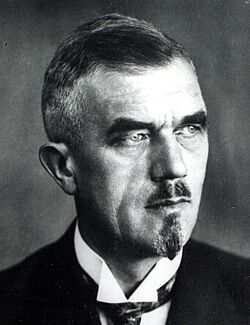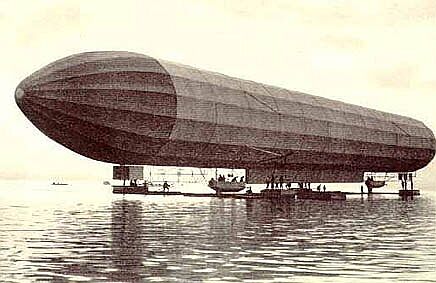12
Zeppeliner
Posted by jns on 12 May 2009 This is Ludwig Dürr (1878–1955), remembered as the chief engineer who built the successful Zeppelin airships.
This is Ludwig Dürr (1878–1955), remembered as the chief engineer who built the successful Zeppelin airships.
After an unsatisfactory one-year period in the navy, Dürr was hired, on 15 January 1899, as an engineer at Luftschiffbau Zeppelin GmbH, the company that had been formed by Count Ferdinand Graf von Zeppelin to build rigid, hydrogen-filled airships. While working at their design offices in Stuttgart he completed his last semester of the Royal School of Mechanical Engineering, took his final exams, then Immediately went back to work for Count Zeppelin, moving to the company’s new location in Friedrichshafen, in southwest Germany on the north shore of Lake Constance (“Bodensee” ).
Zeppelin’s company, in the beginning, was beset with difficulties raising money and avoiding disaster. The first dirigible, known as LZ 1 (LZ = “Luftschiff Zeppelin” or “Zeppelin Airship”), at 420 feet long and 32.8 feet in diameter (the largest thing ever built to fly at that time), the airship proved underpowered and hard to manage in strong winds. Bad publicity meant no hoped-for government funding. LZ 1 was broken up for scrap and the company dissolved.
However, Zeppelin kept Dürr around. A few years later King Karl of Württemberg lent his support and Zeppelin, with Dürr as his chief engineer, set out to build LZ 2. This new ship was the same size as LZ 1 but had more power engines (provided by Daimler, as before). It was launched in January1906 from its floating hanger on Lake Constance, as seen in this photograph.

Unfortunately, LZ 2 was also difficult to maneuver in strong winds, but Zeppelin and his crew managed an emergency landing when an engine failed. While they celebrated their safe landing, LZ 2 was destroyed by a storm.
LZ 3, launched that October, flew several flights successfully, but the government wasn’t terribly impressed yet. They gave him money to continue some work, promising to buy LZ3 and LZ 4, provided the latter could stay in the air for 24 hours.
In August 1908 the new airship was taken for a flight up the Rhine Valley. Again, engine failure forced the dirigible down. A storm came along, blew the nose of the ship into a stand of trees, and a hole tore in the gas bags. Rubberized material, flapping the wind, generated a spark that ignited escaping hydrogen and LZ 4 went up in flames.
Now the indefatigable Zeppelin finally felt like the time had come to give up. But then, what happened?
Prepared at last to accept defeat, the seventy-year old Count was stunned by the public outpouring of support that would be remembered as “the miracle of Echterdingen.” Almost without his noticing it, the Count, who had persevered in the face of overwhelming disappointments, emerged as a revered public figure. The old man and his airships decorated a wide range of consumer items, from children’s candies to ladies’ purses, hair brushes, cigarettes and jewelry cases. Copies of the soft white yachting cap that was the Count’s sartorial trademark were sold in stores across Germany, along with an assortment of items from toys to harmonicas bearing Zeppelin’s image. Schools, streets and town squares were renamed in his honor. And now, in his time of greatest need, the German people came to the support of the Count.
In an age of rampant nationalism, Germans looked to the Zeppelin airship as a symbol of national pride. From the Kaiser to the youngest schoolchild, Germans dispatched money to the Count, the sum eventually reaching 6.25 million marks. Those who could not afford to make a cash contribution sent farm products, home-made clothing, anything they thought might help. The ill-fated flight of LZ 4 up the Rhine, Zeppelin would later remark, had been his “luckiest unlucky trip”.
[Tom D. Crouch, Lighter Than Air: An Illustrated History of Balloons and Airships (Baltimore : The Johns Hopkins University Press, 2009), p. 83.]
Zeppelin reformed his company, still with the loyal Dürr as chief engineer, and this time success was theirs and Zeppelin’s name is etched in popular history.
Dürr’s name is not quite so well known as Zeppelin’s, but he’s not forgotten. I was delighted to discover that there is a school in Friedrichshafen named in his honor — the Ludwig-Dürr-Schule — where they are justifiably quite proud of their namesake. Here is the google translation of the page “How has our school its name?” that I’ve enjoyed reading. Visit the welcome page and you can also see the staff plus the menus for lunch.
On the subject of zeppelins, here is a nice, short history by the US Centennial of Flight commission.
There is a Zeppelin Museum in Friedrichshafen. Among many interesting exhibits there is a reconstruction of the passenger areas of the LZ 129 Hindenburg, which famously burst into flames and crashed during landing in Lakehurst, New Jersey on 6 May 1937, killing 35 of the 97 passengers and crewmen aboard. The tragedy brought an end to the practice of filling lighter-than-air ships with highly flammable hydrogen.
Luftschiffbau Zeppelin GmbH is now known as Zeppelin Luftschifftechnik GmbH (in English), and they still build zeppelins. I read that, in conjunction with Airship Ventures, Inc., one of their new zeppelins is making commercial, mostly sightseeing, flights near San Francisco.
Finally, some visual dessert.
- This page has a nice collection of images of zeppelins in world stamps.
- This page, thanks to the generosity of the grandmother of one Charlie Grant, offers a collection of newspaper clippings about the Hindenburg and its tragic end.